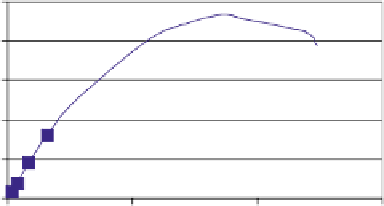Environmental Engineering Reference
In-Depth Information
500
Fig. 5.3
Power density of the
MFC using dairy wastewater
as the energy source
400
300
200
100
0
0.0
2.0
4.0
6.0
mA
5.3.4 Complex Organic Matter in Dairy Processing Wastewater
The Mayfield wastewater potentially contained complex organic carbon in the form
of dissolved as well as suspended particulate matter. The HPLC analysis indicated
a total of about 0.5 g/L dissolved solids in the wastewater. This amount of organic
carbon would provide continuous power for a period of 8 days, assuming 100%
coulombic efficiency and a current output of 2.1 mA. This is based on a total volume
of 230 mL (maximum volume of MFC system, including the reservoir). The BOD of
the wastewater was approximately 2.25 g/L (equivalent to 2.12 g/L carbohydrate).
Thus, about 1.62 g/L of the carbohydrate-equivalent organic matter was present in
a complex organic form.
5.3.5 Assessment of MFC/MEC Application for Food Industry
Wastewater Treatment
In application of bioelectrochemical systems for treatment of food processing
wastewaters, a number of factors need detailed assessment, especially if the goal
is to maximize energy generation. In the following subsections, we review and dis-
cuss energy production from complex organic matter, potential changes to improve
power densities and pursue practical applications and potential for water reuse in
the industry.
5.3.5.1 Deriving Energy from Complex Organic Matter
Electricity production from starch, molasses, cellulose, protein and other complex
carbon sources has been reported using MFCs [14, 39, 41-44]. Deriving energy
from the complex, soluble as well as suspended organic matter in food processing
waters therefore should be possible, but further work is required to demonstrate the
degree of conversion of these wastewater constituents. The suspended particulates
may require modified MFC designs to handle solids or pretreatment to solubilize




